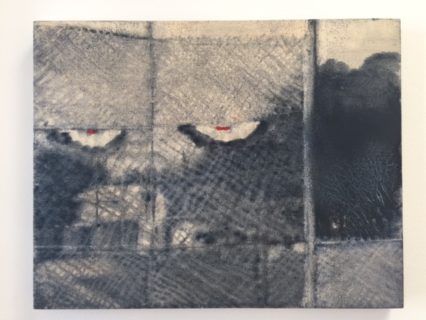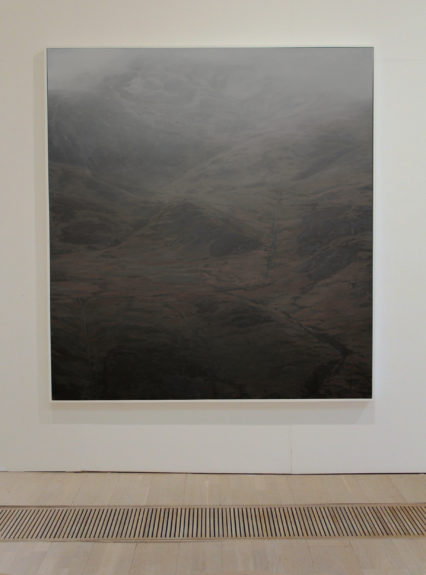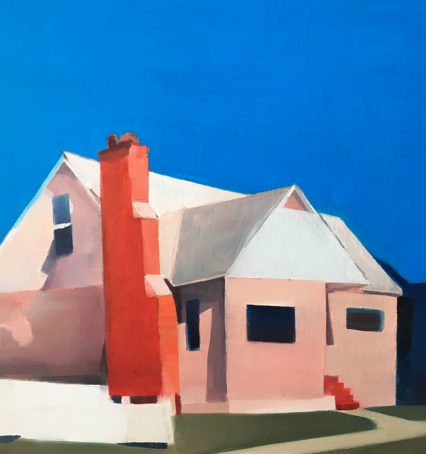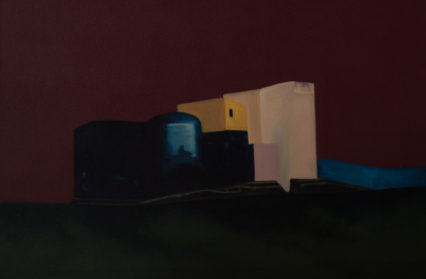The second biennial Beep show and competition organised principally by Jonathan Powell, a painter and director of Swansea’s Elysium gallery and studios, was shown first in Swansea’s art school, before it goes to Wrexham and then Cardiff. Here The Afternoon Critic gives an in-depth overview of this year’s show and asks if, by giving the competition a theme, it is not trapping the progress of painting.
72 paintings by 49 artists were chosen from a much larger international field invited to respond to a theme ‘This must be the place I never wanted to leave…’ The website elaboration of this was rather confusing but did not put people off submitting. Things become clearer in the forward to the catalogue where Powell says the theme grew out of discussions in the High Street studios project space which eventually focused on ‘what certain places and spaces meant to people’ and how paint might be used to ‘explore an understanding of place.’ A central idea is that painting might be a way ‘to remove oneself from the world and become absent from a place.’ However this focus on individual meanings and withdrawal from the world is countered by something more collective when acknowledging the importance of group discussion and material help putting the exhibition together. This may be a key to understanding the whole exhibition.

There is no interest in second-guessing the judgments about which paintings should be selected, commended, or win prizes. This approach means that the exhibition is treated as a complete object in its own right, to be experienced as a visitor’s ‘event’, assisted only by the catalogue. The 72 pictures had titles and artists’ names but no ‘statements’ and no CVs. This is helpful – the looking is not obscured by theoretical ‘explanations’, philosophical justifications or autobiographical stories about personal journeys, academic qualifications etc. and the sort of collateral information typically found on artists’ websites. We are given only two Forwards : Jonathan Powell’s already described, and another by Dalit Shalgi-Leon supplies a dense paragraph of phenomenological/ontological meditation on the experience and signification of place(s). This is the only concession to supporting the paintings with text. But given how little there is and how obscure some of it might seem (I think I understood it but can’t be sure), the paintings are left to look after themselves. There are no comments from the two judges, Shani Rhys James and Jonathan Watkins, though Watkins is quoted talking about the winning entry by Tom Banks on several websites.
However, what is clear is that the exhibition is not only an artefact of the theme but also of Powell, who takes sole responsibility for the selection from the much larger number of submissions. In a real sense it is his ‘work’, composed from the works of entrants.
In practice it’s likely he consulted informally about the selection, and was keen to ensure the exhibition could be said to be sufficiently ‘international’. But as consultation was not acknowledged we can take it as his product. This means that if we find any generalities they may be partly explained as conditioned by the curator and not just the artists. This factor may also explain why works are included which are not obviously dealing with the theme of place: these thematic ‘outliers’ may lack titles and/or lack immediate links to the theme provided by the majority. This suggests that they are included for their value as paintings, which in turn suggests that responding to the theme was not actually required. Though most are responses to it, the inclusion of such ‘outliers’ suggests that Powell is primarily interested by a kind of painting, rather than simply ‘understandings of place’.
Three visits to the Swansea exhibition resulted in a feeling that the show had a dominant mood. The chief impression was that the collection of works (with exceptions) exhibited a pattern of characteristics which may be almost systematic. In response to this feeling, an initial analytical move is to identify various ways the works may be grouped. Identify what they may have in common may offer clues about how they function to create the ‘mood’ and a ‘way of seeing’. I’m taking my cue from Berger’s ‘Ways of Seeing’ (1972) in which ‘oil painting’ is argued to facilitate seeing reality as tangible potential or actual property. It may be that BEEP 2016 is the product of various mechanisms which create its own ‘way of seeing’ which may or may not have anything in common with Berger’s characterisation of the oil painting tradition.
The show’s feeling tone is melancholic, sad, defensive, nostalgic, dys/u-topian. Isn’t it fair to say the show is dominated by a sense of loss and a sense that what has been lost is in the past, accessible either in memory or to be regained in some fantasy future? The big absence is any sense of an actionable present. So another way of characterising the mood is to describe it as ‘treading water’, a posture of surviving in the present, sustaining stasis.
This mood implies a political attitude. Think about what isn’t there – it is short on hope, humour, irony, joy, possibility, struggle, and above all else the emotions that are generated by joining groups, and making common cause. These latter are feelings which go with trying to recover or replace what has been lost, in projects conducted in a deep present, drawing on the past to make gains which, though less than perfect and contaminated by having to make compromises, are nevertheless worth striving for. This sort of realistic politics offers no guarantees but does depend on recognising possibilities, making strategic choices, investing time and resources, being prepared for set-backs and so on. The art of such an approach would evoke an actionable present, would treat the past as a complex of resources, positive and negative, to be deployed to transition into hopefully a more desirable future. Its feeling tone would be demanding but not naïve. It would steer between the absolutes of ‘nothing’ (hopelessness) and ‘everything’ (utopian longing).

This leads one to question the exhibition’s ‘theme’. This explicitly invited submissions to focus on loss etc. clearly influencing the feeling-tone. There are several issues. First was a theme necessary? Second, if there must be a theme, is it a good idea to ‘pre-interpret’ it to the extent was done by the initial call for entries? Third, was this particular theme a good one? Clearly it did not inhibit submissions but these might have come without one. But it does prevent Beep being a conduit for finding out what artists might choose to paint autonomously.
However, though providing the theme attempts to impose a measure of discipline, it cannot be wholly responsible for the resulting work. Artists could have rebelled against the theme, ironized it, made fun of it (and painting competitions generally) etc. That the theme appealed to so many in the same sort of apparently uncritical way, is a significant feature. It suggests that, for whatever reasons, significant numbers of artists are willing to fall into line for the benefits of entering competitions. Autonomy is in tension with securing a position in the available ‘attention space’. Of course there may have been submissions which ran against the pattern of the exhibition which means that the actual selection of exhibited works must bear some responsibility for the eventual general impression.
The selecting involved preferring painting with a bias of properties. Choices of subject, and the way they are presented result in a limited number of kinds of works. Returning to our first suggestion, can the works be grouped into kinds? Are some kinds more prominent than others? We can try to see if these groups can be viewed as variants of a higher order set which use the means of picture-making (paint, colour, line, the surface, virtual space etc.) according to some quasi-rules or ‘grammar’. Finding such rules would enable us to approach predicting (at a high level of generality admittedly) what would be likely in another hypothetical room. If we can do all this we may have an empirical basis for a ‘way of seeing’. What we are trying to identify are dimensions of pictorial content – that is what the painting presents to viewers by virtue of being a painting and viewed as such, setting aside for a moment all the supporting framing of the exhibition’s theme, and any knowledge about particular artists. What is actually there to be seen?
In this exhibition the dominating impression is surely of ‘low resolution’. In ordinary language pictures might be described as ‘fuzzy’, ‘vague’, ‘misty’, ‘unclear’, ‘soft–focus’ or ‘murky’. This isn’t the only kind of treatment but it is prominent. It certainly dominates the landscapes. It contrasts strongly with the heightened resolution, clarity or luminosity used typically to present architectural futures. I suggest that both ends of this dimension (low and heightened resolution) feed the sense that what is shown is ‘absent’. Low resolution signifies something lost, creating a sense of insecurity. On the other hand, heightened resolution signifies an imaginary future space with the clarity of a dream. It is perhaps symptomatic that the prize winner (Banks) shows an architectural subject in the middle distance, and uses both ends of the pictorial rhetorical strategies which dominate the exhibition by combining a form of heightened lighting (luminosity) with low definition – creating a sort of ‘lost dream space’.
The rhetoric of obscurity (through low resolution, masking or ambiguous viewing distance etc., that is, 50% of the show) to code what is lost, and the rhetoric of raised clarity to code what is dreamed, both imply their opposites, namely, that ordinary lighting and levels of resolution associated with natural vision, code the opposites of loss and dream experiences. These oppositions are consonant with the posture of classical empiricism which equates knowledge with the evidence provided by the bodily senses, particularly vision. If loss is coded by obscurity, possession is coded by clarity. It seems that by responding to the theme of place and associated memories the artists have been negotiating a sort of ‘trap’. Empiricism is shown by this exhibition to run very deep.

There is an extensive critique of empiricism in epistemology and the philosophy of science and knowledge which we won’t discuss here. More relevant is how this empiricism impacts on the character of the painting. Berger, in Ways of Seeing, argues that oil painting, with its highly reflective surface sheen, durability etc., was particularly functional for conveying a visual experience of the permanence of possessed objects by representing the tangibility of their surfaces. (Banks, the winner, pictured in the header of their article, certainly provides the sheen!).
Oil painting mobilised the senses of sight and touch to create clarity, expressing the opposite of the sense of loss. Seeing and touching, both properties of embodied individuals (without social or cultural contamination) gave knowledge and confidence. Empiricism holds knowledge to be derived from the supposedly universal and objective physical and psychological properties of individuals, irrespective of any conditioning by history, social relations and culture. The Beep painters generally operate as if they are individuals who are self-sufficient sources of (their) truths produced by their (unique) experiences. Whereas in fact, their mode of operation and belief in individualism is strongly culturally conditioned. They would probably be horrified to think they were exemplifying empiricism but their willingness to embrace individualism, psychologism and emotivism means their painting has a weak sense of the relational character of reality.
Given this we can see how the Beep show participates in exactly the same ‘way of seeing’ as the classical oil painting tradition, even though (generally) in the mode of inversion. It doesn’t so much negate or transcend the tradition, as use it to express loss rather than possession. Both Beep and the oil painting tradition have the effect of projecting the present out of the realm of historical mutability – both try to fix their objects, make them ‘givens’, ‘naturalise’ them – it’s just the way things are, then, now, and for ever!
As already suggested there is a further irony – the message of the works as a collection, runs against the message of the exhibition itself as an event. The exhibition is an example of collective action in the present to bring about a more desirable future – no problem with that! Beep 2016 – the event – is a model of what can be done and evidence of making persistence pay. The problem is how to bridge the difference between the extremely positive production of the event and the generally less positive production of the individual works. My suggestion is that to bridge that gap means finding ways of painting which might transcend the positive and negative modes of empiricism.

The attempt to do new things with painting in the Beep show is limited. A large number of paintings seem to be pretty much in the style of contemporary painting luminaries such as (most obviously), Peter Doig. If painters are expressing their unique inner selves they are doing it using existing templates. The Beep efforts to do new things are confined to the use of ‘special’ materials. Watercolour (Zhang, Landscape11 and 111; Mansberger, Mystic River, and Kim, Untitled), metals (Cheater, Reflections from the outside (polished steel); O’Connor, Eira (on zinc); Anobile Cukurcuma (Resin); Elkins, Far away land and Fat of the land (paint skins etc. sculpture); Kuiper Pistyll Rhaeadr (sculptural painting (gel)); Stitt, Post-capitalist wall relief and Ree-Morton generic wall panel.. (both oil, enamel and formica on wood panel). Water colour has long been used to subvert the bogus certainties of oil painting, not least by Turner. Experiments with sub-strates, (zinc, wood etc.) and driving painting in a sculptural direction (Anobile, Elkins and Stitt) are common enough. But these moves do nothing to address the basic problem of deciding what painting can be used for.
By proposing the theme, Beep has inadvertently encouraged many individualised artists to enter the empiricist trap. By organising the exhibition, Beep effectively conserves the practice of painting against its competitors, but despite its best intentions it has resulted in a rather traditional, defensive, show. Next time round it needs to be more confident. Painting is here to stay and needs to be pursued much more ambitiously. If the theme had invited artists to explore the variety of possible positive ambitions for painting , rather than to self-reflection about their understandings of place, this might have been avoided. Perhaps the next Beep could invite teams of painters to respond to the challenge of showing the mechanisms producing appearances.












